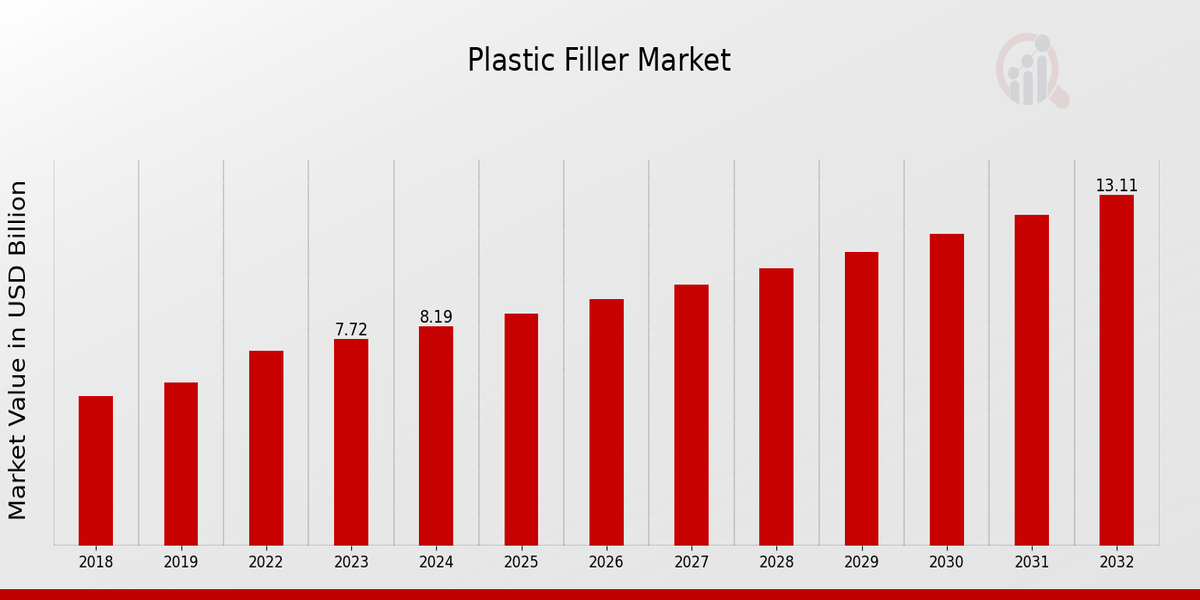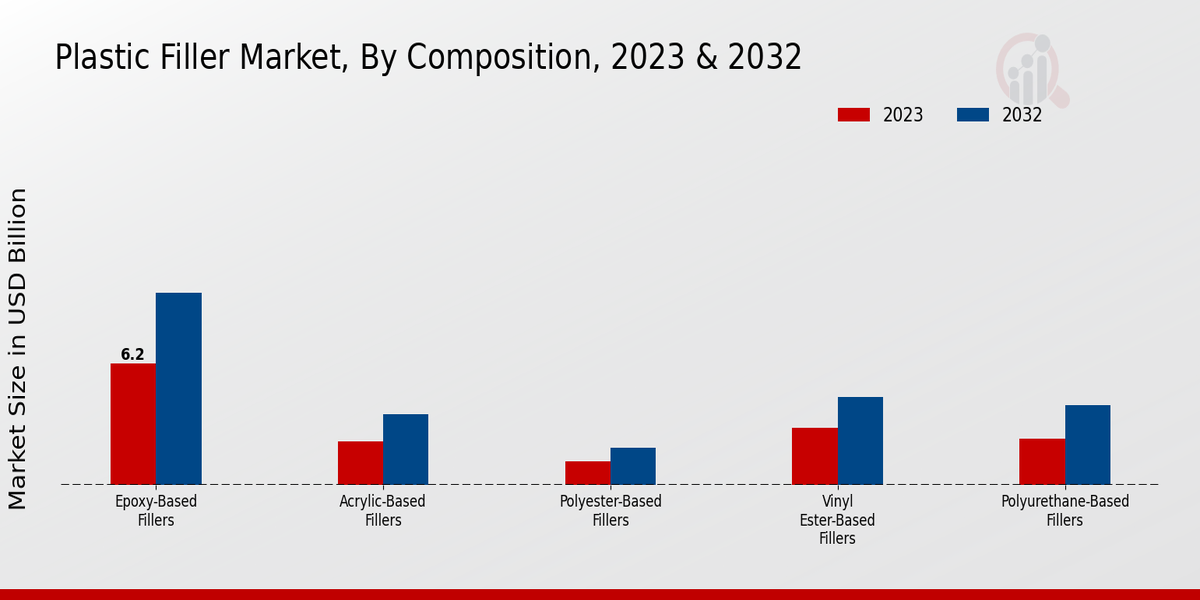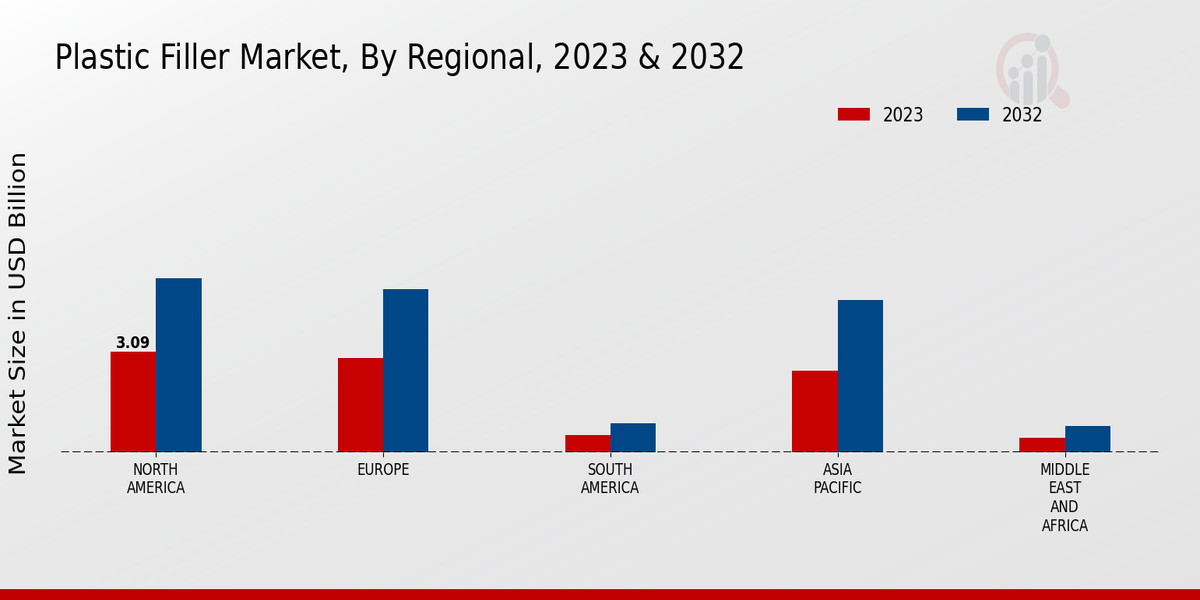Global Plastic Filler Market Overview
The Plastic Filler Market Size was estimated at 8.69 (USD Billion) in 2024. The Plastic Filler Industry is expected to grow from 9.21 (USD Billion) in 2025 to 15.65 (USD Billion) by 2034. The Plastic Filler Market CAGR (growth rate) is expected to be around 6.1% during the forecast period (2025 - 2034).
Key Plastic Filler Market Trends Highlighted
The plastic filler market is anticipated to witness significant growth in the coming years. The increasing demand for lightweight and durable materials in automotive, construction, and other industries is driving the market expansion.
The growing awareness of environmental sustainability and the need to reduce carbon emissions are further propelling the adoption of plastic fillers as lightweight alternatives to traditional materials.
Key market drivers include the increasing production of plastic products, the need to reduce vehicle weight, and the growing demand for lightweight and durable construction materials. The automotive industry remains the largest consumer of plastic fillers, accounting for a significant share of the market.
The construction industry is expected to experience substantial growth owing to the increasing demand for lightweight and cost-effective building materials.
Recent trends in the plastic filler market include the growing popularity of bio-based and sustainable fillers, the development of new and innovative fillers with enhanced properties, and the adoption of advanced manufacturing techniques to improve product quality and efficiency.
The market is expected to witness continued growth in demand for high-performance fillers with specific properties, such as improved strength, thermal stability, and electrical conductivity.

Source Primary Research, Secondary Research, MRFR Database and Analyst Review
Plastic Filler Market Drivers
Increasing Demand from Automotive Industry
The automotive industry is a major consumer of plastic fillers, with the rising production of vehicles driving the demand for these materials. Plastic fillers are used in various automotive components, including bumpers, dashboards, interior trim, and exterior body panels.
The increasing adoption of lightweight materials in the automotive industry, such as plastic composites, is further fueling the growth of the plastic filler market. The use of plastic fillers helps reduce the weight of vehicles, improving fuel efficiency and reducing emissions.
Additionally, the growing demand for electric vehicles (EVs) is also contributing to the growth of the plastic filler market, as EVs require lightweight and durable materials for their construction.
Growing Construction Industry
The construction industry is another key driver of the plastic filler market. Plastic fillers are used in a variety of construction applications, including flooring, roofing, and wall panels.
The rising demand for affordable and durable construction materials is driving the growth of the plastic filler market in this sector. Plastic fillers offer advantages such as low cost, lightweight, and resistance to moisture and chemicals, making them suitable for various construction applications.
Expansion of Aerospace Industry
The aerospace industry is a niche but growing market for plastic fillers. Plastic fillers are used in various aerospace applications, including aircraft interiors, radomes, and composite structures.
The increasing demand for lightweight and durable materials in the aerospace industry is driving the growth of the plastic filler market. Plastic fillers help reduce the weight of aircraft, improving fuel efficiency and performance.
Plastic Filler Market Segment Insights
Plastic Filler Market Composition Insights
The plastic filler market is segmented based on composition into epoxy-based fillers, polyester-based fillers, vinyl ester-based fillers, acrylic-based fillers, and polyurethane-based fillers. Among these, epoxy-based fillers held the largest market share in 2023, and they are projected to continue dominating the market throughout the forecast period.
The growth of the epoxy-based fillers segment can be attributed to their excellent adhesion properties, high strength, and resistance to chemicals and solvents. Polyester-based fillers are another important segment of the plastic filler market.
They are commonly used in automotive, marine, and construction applications due to their low cost and ease of use. Vinyl ester-based fillers offer high strength and toughness, making them suitable for demanding applications such as boat hulls and chemical tanks.
Acrylic-based fillers are known for their excellent clarity and UV resistance, which makes them ideal for use in transparent or translucent applications. Polyurethane-based fillers are gaining popularity due to their lightweight, flexibility, and impact resistance. They are commonly used in automotive interiors, furniture, and electronics.
The increasing demand for lightweight and durable materials in various industries is driving the growth of the plastic filler market. The automotive industry is a major consumer of plastic fillers, as they are used to fill gaps, repair dents, and create smooth surfaces.
The construction industry also uses plastic fillers for repairing cracks, filling holes, and leveling surfaces. The market is expected to reach a valuation of USD 13.1 billion by 2032, up from USD 7.72 billion in 2023. The growth of the market is attributed to the increasing demand for plastic fillers in various industries, such as automotive, construction, and marine.

Source Primary Research, Secondary Research, MRFR Database and Analyst Review
Plastic Filler Market Application Insights
The application segment plays a crucial role in shaping the dynamics of the Plastic Filler Market. In 2023, the Automotive and Transportation segment held the dominant share of the market, accounting for approximately 32.5% of the Plastic Filler Market revenue.
The growing demand for lightweight and fuel-efficient vehicles is expected to drive the growth of this segment in the coming years. The Construction and Infrastructure segment is projected to witness significant growth over the forecast period, reaching a market share of around 27.8% by 2032.
The increasing construction activities ly, particularly in emerging economies, will fuel the demand for plastic fillers in this segment. Marine and Aerospace applications are expected to contribute a notable share to the Plastic Filler Market, with a projected market share of 14.2% by 2032.
The rising demand for lightweight and durable materials in the marine and aerospace industries will drive the growth of this segment. Industrial and Manufacturing applications are anticipated to hold a substantial share of the market, driven by the growing demand for plastic fillers in various industrial processes, such as molding, casting, and coating.
Consumer Goods applications, including paints, coatings, and adhesives, are expected to contribute a significant share to the Plastic Filler Market, with a market share of around 25.5% by 2032. The increasing demand for durable and aesthetically pleasing consumer products will drive the growth of this segment.
Plastic Filler Market Form Insights
The form segment of the plastic filler market is segmented into paste, liquid, powder, gel, and spray. Among these, the paste segment held the largest market share in 2023, accounting for over 35% of the market. The paste form is preferred due to its ease of application and versatility.
It is widely used in automotive, construction, and marine industries for filling and repairing dents, scratches, and other imperfections. The liquid segment is expected to witness the fastest growth during the forecast period, with a CAGR of 6.5% from 2024 to 2032.
The increasing demand for liquid fillers in the automotive and aerospace industries, where lightweight and high-strength materials are required, is driving the growth of this segment. Powder fillers are gaining popularity in the construction industry due to their cost-effectiveness and durability.
They are used in concrete, mortar, and other building materials to improve strength, reduce shrinkage, and enhance fire resistance. Gel fillers offer high precision and controlled application, making them suitable for specialized applications in electronics, medical devices, and aerospace.
Spray fillers are primarily used in automotive and industrial coatings, providing a smooth and even finish. The growth of the plastic filler market is driven by increasing demand from various end-use industries, including automotive, construction, and aerospace. Technological advancements and the development of new formulations are also contributing to the market growth.
Plastic Filler Market End-Use Industry Insights
The Plastic Filler Market segmentation by End-Use Industry offers insights into key verticals utilizing plastic fillers.
The Automotive industry dominates the market with a significant revenue share due to the widespread use of plastic fillers in-vehicle components like bumpers, body panels, and interiors.
The Construction industry follows closely, driven by the demand for lightweight and durable materials in building and infrastructure projects. The Marine industry utilizes plastic fillers for boat hulls, decks, and other components, contributing to its growth.
The Aerospace industry demands high-performance plastic fillers for aircraft components, while the medical industry leverages them for medical devices and equipment. These end-use industries collectively drive the growth of the Plastic Filler Market, with each segment offering unique opportunities for market growth.
Plastic Filler Market Curing Type Insights
The Plastic Filler Market is segmented based on Curing Type into Heat-Curable, UV-Curable, and Room-Temperature Curable. Among these segments, the Heat-Curable segment held the largest market share in 2023 and is expected to continue its dominance throughout the forecast period.
The growth of this segment can be attributed to the increasing demand for heat-curable plastic fillers in the automotive and construction industries. The UV-Curable segment is expected to witness the highest growth rate during the forecast period, owing to the rising popularity of UV-curable plastic fillers in the electronics and aerospace industries.
The Room-Temperature Curable segment is expected to hold a significant market share due to its ease of use and low cost.
Plastic Filler Market Regional Insights
The regional segmentation of the Plastic Filler Market offers valuable insights into the geographical distribution of market growth and opportunities. North America emerged as the dominant regional market in 2023, capturing a significant share of the overall revenue.
The region's robust construction industry, along with increasing demand for plastic fillers in automotive and aerospace applications, has fueled its market growth. Europe follows closely behind, driven by stringent environmental regulations and a growing emphasis on lightweight materials in various industries.
The Asia-Pacific (APAC) region is anticipated to witness the fastest growth over the forecast period. Rapid industrialization, coupled with rising disposable incomes and urbanization, is expected to drive demand for plastic fillers in the region. South America and the Middle East and Africa (MEA) are also expected to contribute to the overall market growth, albeit at a moderate pace.

Source Primary Research, Secondary Research, MRFR Database and Analyst Review
Plastic Filler Market Key Players and Competitive Insights
Major players in the Plastic Filler Market industry are constantly striving to gain a competitive edge by investing in research and development, expanding their product portfolios, and forming strategic partnerships.
Leading Plastic Filler Market players are focusing on developing innovative products that meet the evolving needs of customers. They are also investing in expanding their presence through acquisitions and partnerships. The Plastic Filler Market Competitive Landscape is expected to remain highly competitive in the coming years, with key players vying for market share.
Trinseo, a leading company in the Plastic Filler Market development, offers a wide range of plastic fillers that are used in a variety of applications, including automotive, construction, and consumer products.
The company's commitment to innovation has resulted in the development of several new products, including its line of lightweight, high-strength fillers. Trinseo has also expanded its reach through strategic partnerships and acquisitions.
Another major player in the Plastic Filler Market is Imerys. The company offers a wide range of fillers, including calcium carbonate, talc, and kaolin. Imerys has a strong focus on sustainability and is committed to reducing its environmental impact.
The company has invested in research and development to develop new, more sustainable fillers. Imerys has also expanded its reach through strategic partnerships and acquisitions.
Key Companies in the Plastic Filler Market Include
- Sherwin-Williams
- Sika AG
- Ashland
- PPG Industries
- Henkel
- BASF
- RPM International
- Ferro Corporation
- Evonik Industries
- Huntsman Corporation
- 3M
- Axalta Coating Systems
- DuPont
- Imerys
- Bostik
Plastic Filler Market Industry Developments
The growth is driven by rising demand from the automotive, construction, and packaging industries. The automotive industry is a major consumer of plastic fillers, as they are used to reduce weight and improve the mechanical strength of vehicle parts.
In construction, plastic fillers are used to repair cracks and gaps in walls, floors, and ceilings. The packaging industry uses plastic fillers to enhance the protective properties of packaging materials.
Recent market developments include the launch of new products with improved performance and sustainability.
For instance, in 2023, BASF introduced a new range of plastic fillers that are lightweight, durable, and resistant to chemicals. The growing adoption of bio-based and recycled plastic fillers is also a notable trend, as companies strive to reduce their environmental impact.
Plastic Filler Market Segmentation Insights
- Plastic Filler Market Composition Outlook
- Epoxy-Based Fillers
- Polyester-Based Fillers
- Vinyl Ester-Based Fillers
- Acrylic-Based Fillers
- Polyurethane-Based Fillers
- Plastic Filler Market Application Outlook
- Automotive and Transportation
- Construction and Infrastructure
- Marine and Aerospace
- Industrial and Manufacturing
- Consumer Goods
- Plastic Filler Market Form Outlook
- Paste
- Liquid
- Powder
- Gel
- Spray
- Plastic Filler Market End-Use Industry Outlook
- Automotive
- Construction
- Marine
- Aerospace
- Medical
- Plastic Filler Market Curing Type Outlook
- Heat-Curable
- UV-Curable
- Room-Temperature Curable
- Plastic Filler Market Regional Outlook
- North America
- Europe
- South America
- Asia Pacific
- Middle East and Africa
| Report Attribute/Metric |
Details |
| Market Size 2024 |
8.69(USD Billion) |
| Market Size 2025 |
9.21(USD Billion) |
| Market Size 2034 |
15.65(USD Billion) |
| Compound Annual Growth Rate (CAGR) |
6.1% (2025 - 2034) |
| Report Coverage |
Revenue Forecast, Competitive Landscape, Growth Factors, and Trends |
| Base Year |
2024 |
| Market Forecast Period |
2025 - 2034 |
| Historical Data |
2020 - 2024 |
| Market Forecast Units |
USD Billion |
| Key Companies Profiled |
Sherwin-Williams, Sika AG, Ashland, PPG Industries, Henkel, BASF, RPM International, Ferro Corporation, Evonik Industries, Huntsman Corporation, 3M, Axalta Coating Systems, DuPont, Imerys, Bostik |
| Segments Covered |
Composition, Application, Form, End-Use Industry, Curing Type, Regional |
| Key Market Opportunities |
Rising demand for lightweight vehicles Increasing use in the construction industry Growing adoption of packaging applications Expansion of the automotive sector Advancements in polymer technology |
| Key Market Dynamics |
Rising automotive production, surging demand for lightweight vehicles, the growing construction industry, increasing use in packaging and expanding consumer electronics market |
| Countries Covered |
North America, Europe, APAC, South America, MEA |
Frequently Asked Questions (FAQ) :
The Plastic Filler Market size is projected to reach USD 15.65 billion by 2034, exhibiting a CAGR of 6.1% during the forecast period (2025-2034).
The Asia-Pacific region is expected to dominate the Plastic Filler Market, accounting for the largest market share during the forecast period.
Increasing demand for lightweight and durable materials in automotive and construction industries is a major factor driving the growth of the Plastic Filler Market.
Plastic Fillers are widely used in automotive parts, construction materials, furniture, and appliances.
Key competitors in the Plastic Filler Market include 3M, Henkel, Sika, BASF, and PPG.
Fluctuating raw material prices and environmental regulations pose challenges to the growth of the Plastic Filler Market.
The Plastic Filler Market is expected to exhibit a CAGR of 6.06% during the forecast period (2024-2032).
The base year considered for the Plastic Filler Market forecast is 2023.
The end year considered for the Plastic Filler Market forecast is 2032.

















